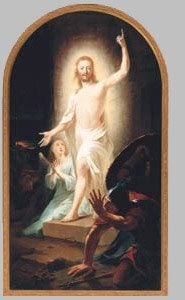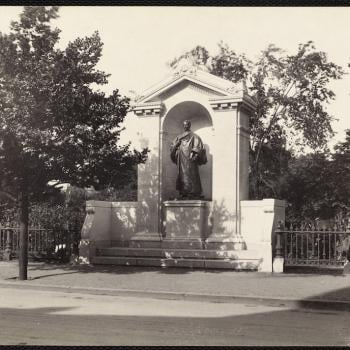An Easter Meditation
James Ishmael Ford
Text
Set me as a seal upon thine heart,
as a seal upon thine arm:
for love is strong as death;
jealousy is cruel as the grave:
the coals thereof are coals of fire,
which hath a most vehement flame.
Song of Solomon
Last Sunday in my reflection on Passover I stated that the story has no basis in history, but how ultimately, that didn’t matter, because it told something profoundly true about all of us. Passover is a myth, not as a lie, but as touching the heart in a terribly important way. In the case of Passover it is about how we are all, or rather, how we’re all invited into a journey from bondage, bondage to so many things, too many things, from that to a larger perspective, to our genuine freedom.
Well, sometime this week a friend asked, “So, given what you said. What about Easter?” In case I didn’t get the point, she added, “It seems like Easter has the same problem as Passover as history.” Of course she’s right. Last year’s bestseller, “Zealot: the Life and Times of Jesus of Nazareth” by Reza Aslan and this year’s “How Jesus Became God” by Bart Ehrman are simply popularizations of mainstream biblical scholarship. It reminds me of how shocking Episcopal bishop John Shelby Spong’s best selling books have been, most of which are simply popularizations of mainstream scholarship, and what that can mean for Christians trying to live honestly with the facts on the ground.
Which are: Jesus lived, he preached a radical gospel, and he was killed for his words. Hard examination of the texts, comparing them to each other and to what we know of the times and place, we can safely assume the belief that he rose from the dead comes later, decades later. And like with Passover, we are given a story that has emerged over time, and which points us to a wondrous truth.
There is something compelling, something that draws the heart in this story of Jesus’ death and resurrection. So, much so, that even in a church like ours that historically shifted its concern, as we like to say from a religion about Jesus to a religion about what Jesus taught, nonetheless, on Easter, many of us find it something powerful to reflect on that myth, myth in the wildly true sense of pointing to the heart of some terribly important matter.
But how do we do this? How can we do this most usefully? I’ve mentioned this option before, but that’s because it makes a lot of sense to me. I hope you see something of value for you here, as well. Some years ago now Jan said we’re going to see a movie from Quebec. I asked if it’s in French? She said yes, but there are subtitles. I sighed. Living with an intellectual can be hard. Then she said, but it’s about religion. And, of course, with that she had me. So, off we went.
I loved that movie. Here we get one way people can deal with the history and the myth, being honest with both. Not the only way, but a good one. The plot for Jesus of Montreal is simple enough. A Catholic priest at a shrine in the city has been presenting a Passion play, one of those reenactments of the story of Jesus, for thirty-five years. Attendance, however, has been dropping off. He approaches an actor, explaining the situation, and concludes, saying, “The text is a bit dated. It needs to be modernized.”
With that the plot plays out. The troop of actors are as unlikely a crowd as Jesus’ disciples were, and pretty much as disreputable. In trying to work out the new script the actor turns to the popularizations of contemporary scholarship. Not much different than reading “Zealot” or “How Jesus Became God,” or, the teachings of the good bishop Spong.
What most mattered for me was how the arc of the story wasn’t so concerned with the history. It was in how the actor portraying Jesus was caught up in the myth, not as lie, but as something terribly importantly true. He began to find the story touching his own life. For instance his temptation was to sell out and do advertising. And, yes, I found it all a bit contrived. But, the important part was the relentless call of a human Jesus, who reminded us of love and called us to serve one another. Here we begin to touch the power of the story, that point I found compelling, as compelling as a crocus bud bursting out of the cold earth.
As the time of fulfillment arrives, the cross in the play crashes down on the actor, crushing him. He is rushed to a hospital, but dies. Critical to this retelling of the story his corneas and his heart are donated, giving new eyes and a renewed life to other people.
There are those who might complain that reducing the story of the life and death of Jesus to an ordinary life, an ordinary death, and a resurrection that is found in organ transplants is something banal, too small a meaning to derive from a story that has sustained generations.
I disagree. Deeply. If you can’t see miracles in this, you can’t see miracles.
I don’t think anyone has to believe in a literal historical Passover to see the powerful currents of our human hearts being held up, and a pointer toward new life for all of us. And, similarly, I don’t think it necessary to believe in a literal resurrection to find the power of giving one’s life for another, and how that leads us all to lives that are transformed, and holy.
I think Jesus of Montreal one of the finest religious films ever made. And it turns on the fact the ordinary is sacred, our lives, our deaths, our hopes, our loves are all miraculous, as miraculous as the budding of that magnolia in the window.
Here we’re called to see real miracles. And these miracles abound.
This is Easter. It’s all about hope.
This is Easter. It’s all about love.
This is Easter. It’s all about a love that is as strong as death.
A love that is as strong as death.
And that is very good news.
Happy Easter, dear ones.
And, amen.













